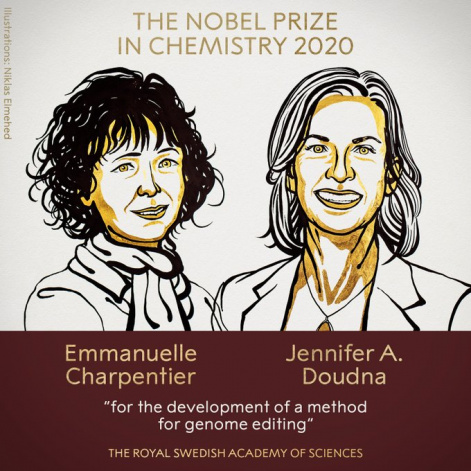Krasnoyarsk scientists about the Nobel Prize 2020: chemistry
8 October 2020 г.

What was the Nobel Prize in Chemistry awarded for?
The 2020 Nobel Prize in Chemistry was awarded to French scientist Emmanuelle Charpentier and American Jennifer Doudna, who jointly developed the genetic scissors method, a genome editing method using the CRISPR-Cas9 system. This method allows one to make point changes in the DNA molecule where the hereditary genetic information of any organism is encrypted.
The discovery of “molecular scissors” was quite unexpected. During the research of Streptococcus pyogenes, one of the bacteria which causes the greatest harm to humanity, Emmanuelle Charpentier discovered a previously unknown molecule. The work of the scientist showed that this molecule is part of the ancient immune system of bacteria (CRISPR / Cas), which disarms viruses by breaking down their DNA. Charpentier published her discovery in 2011. In the same year, she started collaborating with Jennifer Doudna, an experienced biochemist with extensive knowledge of RNA molecules. Together, they managed to recreate the molecular scissors of bacteria in a test tube and simplified the molecular components of the scissors to make them easier to use.
In their natural form, the "scissors" recognize DNA of viruses, but Charpentier and Doudna showed that they can be manipulated so that they can cut any DNA molecule at a predetermined location. The CRISPR-Cas9 system has aroused great interest in the scientific community because it is faster, cheaper, more accurate and more efficient than the other existing genome editing methods.
How does this method work?
CRISPR-Cas9 has been adapted from the natural genome editing system of bacteria. The bacteria capture DNA fragments from invading viruses and use them to create segments of DNA, palindromic repeats known as CRISPR (Clustered Regularly Interspaced Palindromic Repeats). CRISPR allows bacteria to "remember" viruses (or sequences similar to them). If viruses attack again, bacteria use the CRISPR segments to target the viruses' DNA. The bacteria then use a special enzyme to cut the DNA, which incapacitates the virus.
The CRISPR-Cas9 system works similarly in the laboratory. Researchers create a small molecule (fragment of RNA) which can bind to a specific site in the genome. This molecule is paired with the Cas9 enzyme. As in the case of bacteria, the modified RNA is used to recognize the DNA sequence, and the Cas9 enzyme cuts the DNA at a given site. Although Cas9 is most frequently used, other enzymes can also be employed. After the DNA has been cut, the researchers use the cell's own DNA repair mechanism to add or remove fragments of the genetic material, or make changes to the DNA, replacing an existing segment with a sequence of interest.
What is the significance of this discovery?
Since Charpentier and Doudna discovered molecular scissors in 2012, their use in molecular biology research has become very popular. This tool has contributed to many important discoveries in basic research. Using this method, scientists increase crop yields or resistance to diseases and herbicides. In plant breeding, researchers can give plants specific characteristics, for example, the ability to withstand drought in hot climates, or resistance to pests. For example, a wheat variety resistant to powdery mildew was created through gene editing.
Genome editing is of great interest for the prevention and treatment of human diseases. In medicine, CRISPR / Cas9 is contributing to novel cancer immunotherapy as well as to research aimed at treating hereditary diseases. Another application of CRISPR / Cas9, which is likely to be expanded in the future, is the use of transgenic plants or plant cells as factories producing certain substances. Most of the plant varieties created using genome editing are still at the experimental stage. To date, more than 100 plant varieties created using genome editing technologies have been declared unregulated by the USDA.
Researchers have already used gene editing to treat genetic diseases in animals and to fight viruses. They have also used it to prepare pig organs for human transplantation. Clinical trials are under way to understand if CRISPR / Cas9 can be used to treat blood disorders such as sickle cell anemia and beta thalassemia, as well as hereditary eye diseases.
However, along with all the benefits of molecular scissors, there is a number of ethical issues in their use. For example, this system can be used to create genetically modified embryos. There are laws and regulations which control the use of genetic engineering in medicine, which include prohibitions on modifying the human genome in such a way that these changes are inherited. In addition, experiments involving humans and animals must be approved by ethical committees prior to their conduct. The World Health Organization has established a global multidisciplinary group of experts to study scientific, ethical, social and legal issues associated with editing the human genome, with the aim of developing a global governance framework for editing the human genome.
One point is certain: molecular scissors affect all of us. Scientists are constantly faced with new ethical problems, but this new tool may well contribute to solving a lot of problems that are currently urgent for humanity. Through their discovery, Emmanuelle Charpentier and Jennifer Doudna developed a method bringing life sciences into a new era, which will help make new and unexpected discoveries in the future.
Share:
